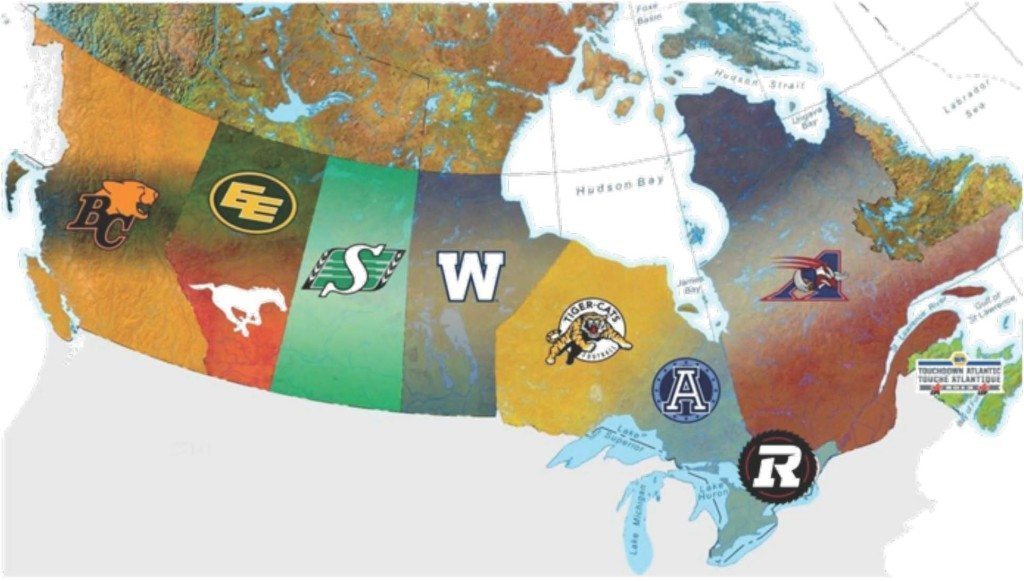[tps_title]CFL Makes Rule Changes[/tps_title]
All sporting leagues bear the responsibility of examining their rules in an effort to improve their style of game as it changes over time. Some do it on a yearly basis and others do it less frequently. The Canadian Football League meets once a year.
Canadian football has rules that make it unique from its American counterpart. In most cases, in other countries that play gridiron style football, the NFL/NCAA rules have been applied in near exact form. There are many reasons the U.S.A. and Canada, who share the 49th parallel, don’t share as much when it comes to the rules and strategy for their versions of gridiron football.
The Canadian in CFL
In the CFL, the roster is currently 46 players. A team may dress up to 44 players on game day with two scratches.
That 44 man game day roster is comprised of 21 Nationals/Canadians, 20 Internationals/imports, and three quarterbacks which are almost always of American lineage.
The 21:20:3 ratio makes a CFL General Manager’s job very difficult. It brings a level of gamesmanship to their job that is a big factor in wins or losses. All due to the philosophies and the personnel systems or ratio tactics that they and their coaching staffs employ.
To obtain an edge, a GM in the CFL works closely with a diligent scouting department that scour for talent. Within Canada, the two major streams are Canadian Inter-University Sport or CIS, and the Canadian Junior Football League or CJFL.
It’s not a thin talent pool but it’s not as prolific as the NCAA’s graduating class. The NCAA is where more Canadian players earn scholarships every year and are subsequently drafted to NFL and CFL clubs.
The GM who stocks his team with the best Canadians gives his coaching staff a distinct advantage.
The CFL We Know
Historically famous and immediately identifiable as a CFL rule is the Rouge. It is one point awarded when the kicking team kicks into the end zone by any legal means, and the ball is not returned by the receiving team or when the ball goes through the back or sides of the end zone. If you’ve never heard anything else about this great league, you’ve probably heard of the Rouge in one of its many pop culture references.
Another traditional rule that separates the CFL, and that might be familiar with an international crowd, is the “No Yards” rule on punt return formations. If a coverage player infringes into a five yard territory around the ball returner the coverage player earns a five yard penalty, if the ball bounces before first contact or 15 yards if the returner catches the punt.
The New Rules
The CFL’s competition committee met in March to discuss rule changes for the 2015 season. After the meeting, they made nine recommendations known to the board of governors who has since narrowed them down and ratified seven of nine committee suggestions.
The focus for the league is multifaceted. Ideally they’d like to have the games fit into a three hour broadcast slot. To achieve this they will reduce penalties, speed up the tempo of the offense, and hopefully increase the big plays on special teams and offense to drive the point totals upward. Here is a look at some of the proposed changes.
Intro of 35 Second Play Clock
Traditionally there was a 20 second play clock between offensive plays. The clock only started when the referee spots the ball AND blows his whistle at his discretion to allow for teams to substitute players and formations. This former process was thought to take about 42 seconds on average.
The CFL Board of Governors ruled in favor of the suggestion to have a :35 second clock that starts as soon as the referee spots the ball he will blow his whistle to start the clock. Much like a basketball shot clock that begins when the inbounding team touches the ball. This change will take a 42 second process and make it 35 seconds consistently and net seven seconds for each play.
Going For Two
In the CFL, currently and historically, teams have elected to go for two points when the score indicates that they need to do so rather than the typical kicked point-after-touchdown converts.
The BOG agreed that by moving the kick for a converted extra point back 20 yards, it would make it less of a chip shot. In combination with moving the two point conversion attempt up from the current five yard line-of-scrimmage to the three yard line, teams have more cause to go for two and less incentive to risk a 32 yard kick for one point.
More Room To Move
In an effort to stop the clutching and grabbing between receivers and defensive backs, the league has more clearly
defined the contact that can occur. Now, a DB cannot impede or redirect an offensive player outside of five yards into the defensive backfield. Formerly, receivers were being grabbed as many as 12 yards downfield and that gave defences a distinct advantage.
These changes will make for an even faster moving game where defences are kept on their toes more. It might also work better for the broadcasts on Canada’s leading television sports network – TSN. Conversations are heating up as clubs are less than two months from training camp. Be sure to catch all the exciting action on ESPN 2 and 3 around the world and on TSN in Canada.

